International Tourism System Report 2022
VerifiedAdded on 2022/10/11
|13
|3773
|13
AI Summary
Contribute Materials
Your contribution can guide someone’s learning journey. Share your
documents today.
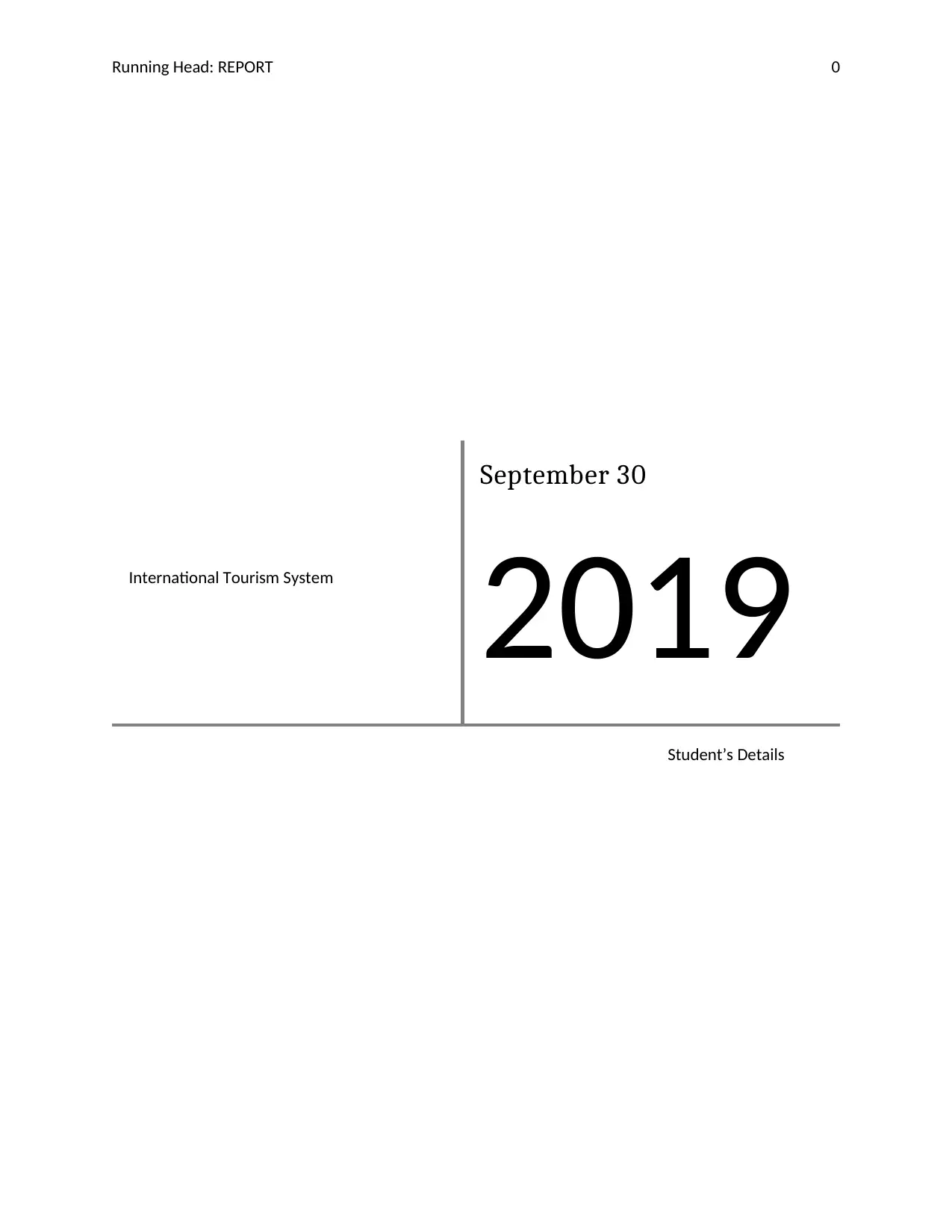
Running Head: REPORT 0
International Tourism System
September 30
2019
Student’s Details
International Tourism System
September 30
2019
Student’s Details
Secure Best Marks with AI Grader
Need help grading? Try our AI Grader for instant feedback on your assignments.
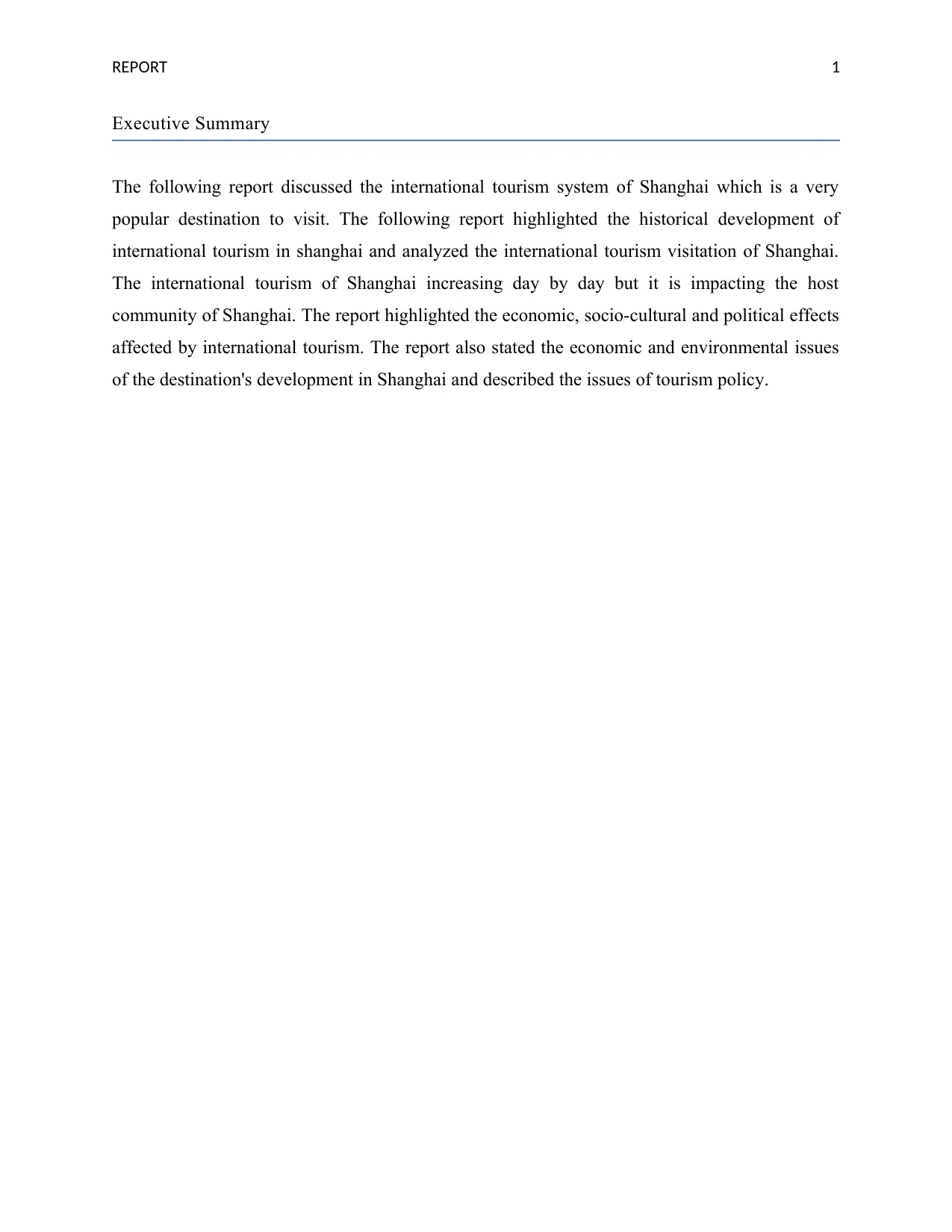
REPORT 1
Executive Summary
The following report discussed the international tourism system of Shanghai which is a very
popular destination to visit. The following report highlighted the historical development of
international tourism in shanghai and analyzed the international tourism visitation of Shanghai.
The international tourism of Shanghai increasing day by day but it is impacting the host
community of Shanghai. The report highlighted the economic, socio-cultural and political effects
affected by international tourism. The report also stated the economic and environmental issues
of the destination's development in Shanghai and described the issues of tourism policy.
Executive Summary
The following report discussed the international tourism system of Shanghai which is a very
popular destination to visit. The following report highlighted the historical development of
international tourism in shanghai and analyzed the international tourism visitation of Shanghai.
The international tourism of Shanghai increasing day by day but it is impacting the host
community of Shanghai. The report highlighted the economic, socio-cultural and political effects
affected by international tourism. The report also stated the economic and environmental issues
of the destination's development in Shanghai and described the issues of tourism policy.

REPORT 2
Contents
Introduction......................................................................................................................................3
Historical development of tourism in Shanghai..............................................................................3
International tourism visitation analysis..........................................................................................4
Attractiveness of Shanghai..............................................................................................................5
Impacts of tourism activity on the host community at the Shanghai...............................................6
Economic effects of tourism........................................................................................................6
Socio-cultural effects of tourism..................................................................................................6
Negative effects of social and culture on tourism....................................................................7
Positive effects of society and culture on tourism....................................................................7
Political effects.............................................................................................................................7
Issues of destination development...................................................................................................8
Economic Issues...........................................................................................................................8
Environmental Issues...................................................................................................................8
Tourism policy issue........................................................................................................................9
Conclusion.....................................................................................................................................10
References List..............................................................................................................................11
Contents
Introduction......................................................................................................................................3
Historical development of tourism in Shanghai..............................................................................3
International tourism visitation analysis..........................................................................................4
Attractiveness of Shanghai..............................................................................................................5
Impacts of tourism activity on the host community at the Shanghai...............................................6
Economic effects of tourism........................................................................................................6
Socio-cultural effects of tourism..................................................................................................6
Negative effects of social and culture on tourism....................................................................7
Positive effects of society and culture on tourism....................................................................7
Political effects.............................................................................................................................7
Issues of destination development...................................................................................................8
Economic Issues...........................................................................................................................8
Environmental Issues...................................................................................................................8
Tourism policy issue........................................................................................................................9
Conclusion.....................................................................................................................................10
References List..............................................................................................................................11
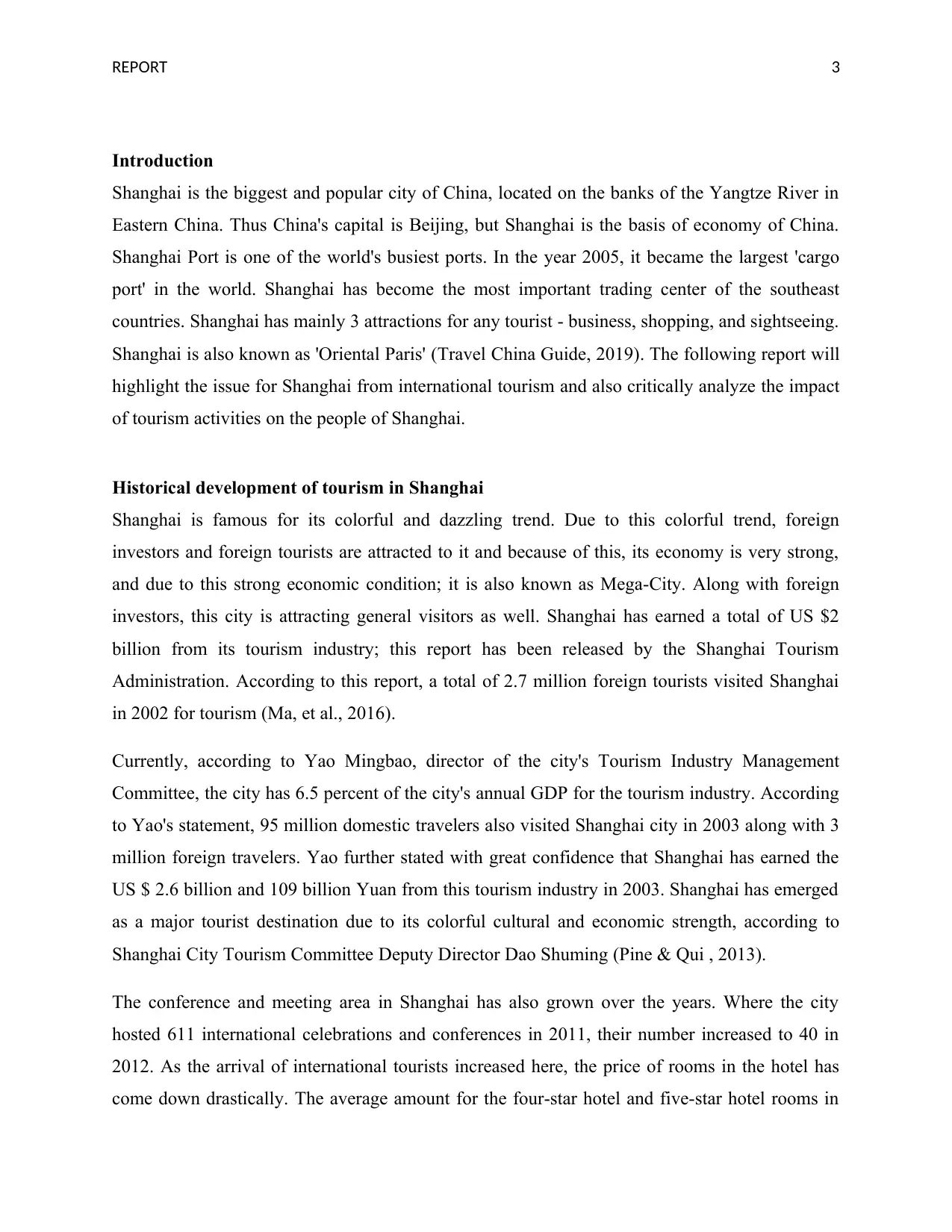
REPORT 3
Introduction
Shanghai is the biggest and popular city of China, located on the banks of the Yangtze River in
Eastern China. Thus China's capital is Beijing, but Shanghai is the basis of economy of China.
Shanghai Port is one of the world's busiest ports. In the year 2005, it became the largest 'cargo
port' in the world. Shanghai has become the most important trading center of the southeast
countries. Shanghai has mainly 3 attractions for any tourist - business, shopping, and sightseeing.
Shanghai is also known as 'Oriental Paris' (Travel China Guide, 2019). The following report will
highlight the issue for Shanghai from international tourism and also critically analyze the impact
of tourism activities on the people of Shanghai.
Historical development of tourism in Shanghai
Shanghai is famous for its colorful and dazzling trend. Due to this colorful trend, foreign
investors and foreign tourists are attracted to it and because of this, its economy is very strong,
and due to this strong economic condition; it is also known as Mega-City. Along with foreign
investors, this city is attracting general visitors as well. Shanghai has earned a total of US $2
billion from its tourism industry; this report has been released by the Shanghai Tourism
Administration. According to this report, a total of 2.7 million foreign tourists visited Shanghai
in 2002 for tourism (Ma, et al., 2016).
Currently, according to Yao Mingbao, director of the city's Tourism Industry Management
Committee, the city has 6.5 percent of the city's annual GDP for the tourism industry. According
to Yao's statement, 95 million domestic travelers also visited Shanghai city in 2003 along with 3
million foreign travelers. Yao further stated with great confidence that Shanghai has earned the
US $ 2.6 billion and 109 billion Yuan from this tourism industry in 2003. Shanghai has emerged
as a major tourist destination due to its colorful cultural and economic strength, according to
Shanghai City Tourism Committee Deputy Director Dao Shuming (Pine & Qui , 2013).
The conference and meeting area in Shanghai has also grown over the years. Where the city
hosted 611 international celebrations and conferences in 2011, their number increased to 40 in
2012. As the arrival of international tourists increased here, the price of rooms in the hotel has
come down drastically. The average amount for the four-star hotel and five-star hotel rooms in
Introduction
Shanghai is the biggest and popular city of China, located on the banks of the Yangtze River in
Eastern China. Thus China's capital is Beijing, but Shanghai is the basis of economy of China.
Shanghai Port is one of the world's busiest ports. In the year 2005, it became the largest 'cargo
port' in the world. Shanghai has become the most important trading center of the southeast
countries. Shanghai has mainly 3 attractions for any tourist - business, shopping, and sightseeing.
Shanghai is also known as 'Oriental Paris' (Travel China Guide, 2019). The following report will
highlight the issue for Shanghai from international tourism and also critically analyze the impact
of tourism activities on the people of Shanghai.
Historical development of tourism in Shanghai
Shanghai is famous for its colorful and dazzling trend. Due to this colorful trend, foreign
investors and foreign tourists are attracted to it and because of this, its economy is very strong,
and due to this strong economic condition; it is also known as Mega-City. Along with foreign
investors, this city is attracting general visitors as well. Shanghai has earned a total of US $2
billion from its tourism industry; this report has been released by the Shanghai Tourism
Administration. According to this report, a total of 2.7 million foreign tourists visited Shanghai
in 2002 for tourism (Ma, et al., 2016).
Currently, according to Yao Mingbao, director of the city's Tourism Industry Management
Committee, the city has 6.5 percent of the city's annual GDP for the tourism industry. According
to Yao's statement, 95 million domestic travelers also visited Shanghai city in 2003 along with 3
million foreign travelers. Yao further stated with great confidence that Shanghai has earned the
US $ 2.6 billion and 109 billion Yuan from this tourism industry in 2003. Shanghai has emerged
as a major tourist destination due to its colorful cultural and economic strength, according to
Shanghai City Tourism Committee Deputy Director Dao Shuming (Pine & Qui , 2013).
The conference and meeting area in Shanghai has also grown over the years. Where the city
hosted 611 international celebrations and conferences in 2011, their number increased to 40 in
2012. As the arrival of international tourists increased here, the price of rooms in the hotel has
come down drastically. The average amount for the four-star hotel and five-star hotel rooms in
Secure Best Marks with AI Grader
Need help grading? Try our AI Grader for instant feedback on your assignments.
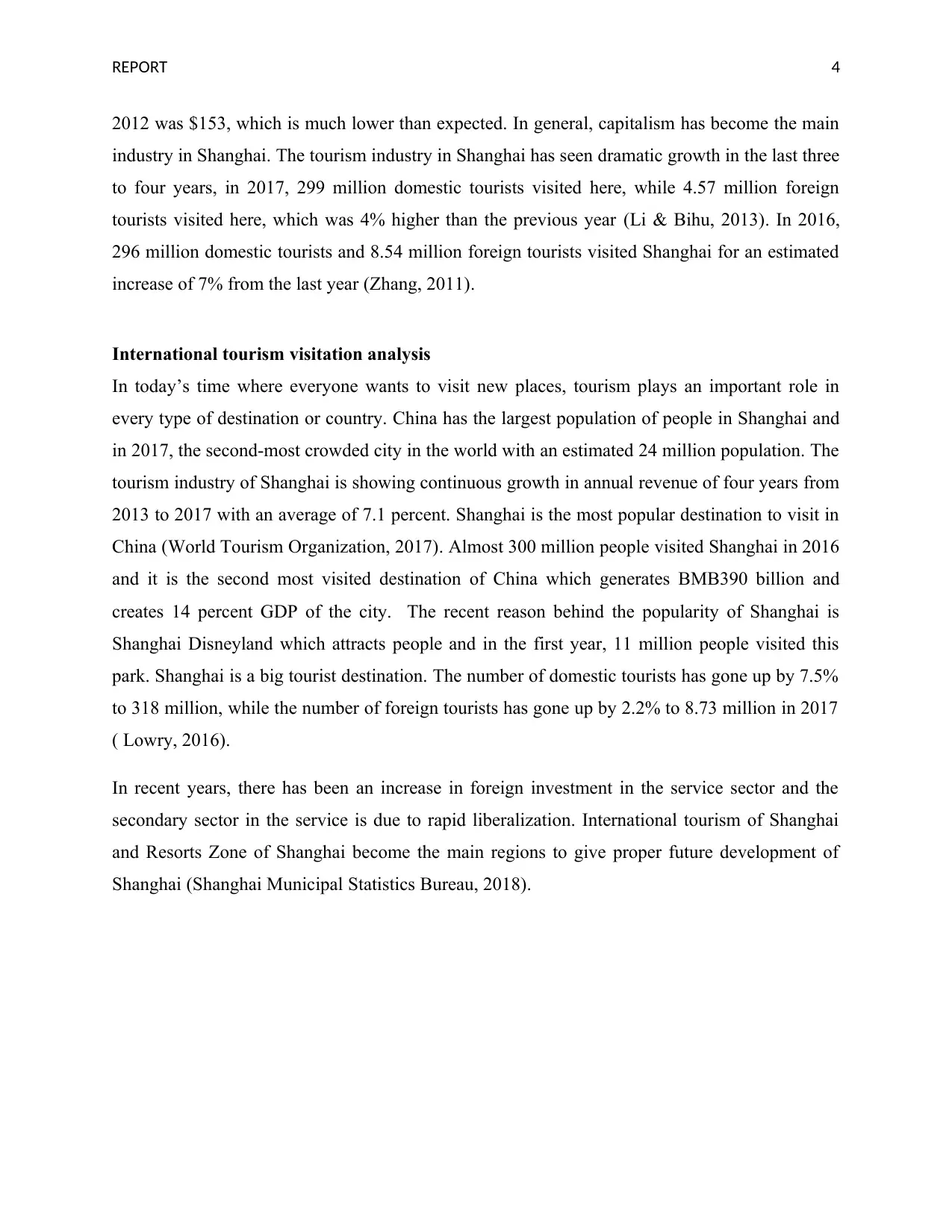
REPORT 4
2012 was $153, which is much lower than expected. In general, capitalism has become the main
industry in Shanghai. The tourism industry in Shanghai has seen dramatic growth in the last three
to four years, in 2017, 299 million domestic tourists visited here, while 4.57 million foreign
tourists visited here, which was 4% higher than the previous year (Li & Bihu, 2013). In 2016,
296 million domestic tourists and 8.54 million foreign tourists visited Shanghai for an estimated
increase of 7% from the last year (Zhang, 2011).
International tourism visitation analysis
In today’s time where everyone wants to visit new places, tourism plays an important role in
every type of destination or country. China has the largest population of people in Shanghai and
in 2017, the second-most crowded city in the world with an estimated 24 million population. The
tourism industry of Shanghai is showing continuous growth in annual revenue of four years from
2013 to 2017 with an average of 7.1 percent. Shanghai is the most popular destination to visit in
China (World Tourism Organization, 2017). Almost 300 million people visited Shanghai in 2016
and it is the second most visited destination of China which generates BMB390 billion and
creates 14 percent GDP of the city. The recent reason behind the popularity of Shanghai is
Shanghai Disneyland which attracts people and in the first year, 11 million people visited this
park. Shanghai is a big tourist destination. The number of domestic tourists has gone up by 7.5%
to 318 million, while the number of foreign tourists has gone up by 2.2% to 8.73 million in 2017
( Lowry, 2016).
In recent years, there has been an increase in foreign investment in the service sector and the
secondary sector in the service is due to rapid liberalization. International tourism of Shanghai
and Resorts Zone of Shanghai become the main regions to give proper future development of
Shanghai (Shanghai Municipal Statistics Bureau, 2018).
2012 was $153, which is much lower than expected. In general, capitalism has become the main
industry in Shanghai. The tourism industry in Shanghai has seen dramatic growth in the last three
to four years, in 2017, 299 million domestic tourists visited here, while 4.57 million foreign
tourists visited here, which was 4% higher than the previous year (Li & Bihu, 2013). In 2016,
296 million domestic tourists and 8.54 million foreign tourists visited Shanghai for an estimated
increase of 7% from the last year (Zhang, 2011).
International tourism visitation analysis
In today’s time where everyone wants to visit new places, tourism plays an important role in
every type of destination or country. China has the largest population of people in Shanghai and
in 2017, the second-most crowded city in the world with an estimated 24 million population. The
tourism industry of Shanghai is showing continuous growth in annual revenue of four years from
2013 to 2017 with an average of 7.1 percent. Shanghai is the most popular destination to visit in
China (World Tourism Organization, 2017). Almost 300 million people visited Shanghai in 2016
and it is the second most visited destination of China which generates BMB390 billion and
creates 14 percent GDP of the city. The recent reason behind the popularity of Shanghai is
Shanghai Disneyland which attracts people and in the first year, 11 million people visited this
park. Shanghai is a big tourist destination. The number of domestic tourists has gone up by 7.5%
to 318 million, while the number of foreign tourists has gone up by 2.2% to 8.73 million in 2017
( Lowry, 2016).
In recent years, there has been an increase in foreign investment in the service sector and the
secondary sector in the service is due to rapid liberalization. International tourism of Shanghai
and Resorts Zone of Shanghai become the main regions to give proper future development of
Shanghai (Shanghai Municipal Statistics Bureau, 2018).

REPORT 5
Source: (Shanghai Government, 2018)
The above table is clearly highlighting the number of overseas tourists through Shanghai
customers.
Attractiveness of Shanghai
The leisure industry is one of the fastest-growing industries in the world. For the leisure
business, it is very important to satisfy the customers. When passengers are not happy or not
satisfied with the service or destination, they do not have the opportunity to return to that
destination. In today's time, the travelers are attracted to the destination when it is unique from
some other destinations. Tourist motivation is the encouragement and pulls theory and according
to this theory, the purpose of traveling for individuals to push by the means of external forces as
well as internal forces at the same time to take interest in the features of destination (CAB books,
2011).
Shanghai is China’s richest city which has cultural centers and the greatest economy and it is the
biggest attraction of this place as it is considered as the most modern city of China. Shanghai is a
city in China that was initially known as an open port. Shanghai is a witness to two world wars
and during these wars, the city was a refuge home for Jewish and Russian refugees, so the city
has experienced colonial history. Even today, stories of that turbulent history can be heard in this
Source: (Shanghai Government, 2018)
The above table is clearly highlighting the number of overseas tourists through Shanghai
customers.
Attractiveness of Shanghai
The leisure industry is one of the fastest-growing industries in the world. For the leisure
business, it is very important to satisfy the customers. When passengers are not happy or not
satisfied with the service or destination, they do not have the opportunity to return to that
destination. In today's time, the travelers are attracted to the destination when it is unique from
some other destinations. Tourist motivation is the encouragement and pulls theory and according
to this theory, the purpose of traveling for individuals to push by the means of external forces as
well as internal forces at the same time to take interest in the features of destination (CAB books,
2011).
Shanghai is China’s richest city which has cultural centers and the greatest economy and it is the
biggest attraction of this place as it is considered as the most modern city of China. Shanghai is a
city in China that was initially known as an open port. Shanghai is a witness to two world wars
and during these wars, the city was a refuge home for Jewish and Russian refugees, so the city
has experienced colonial history. Even today, stories of that turbulent history can be heard in this

REPORT 6
city. The Oriental Pearl TV Tower is the most prominent attraction of tourists. It has been named
'Photographic Jewel', that is, by capturing it in the camera; photography enthusiasts can get a lot
of satisfaction. This tower built in Pudong Park is surrounded by the Yangpu Bridge. The scene
of this looks as 2 dragons are playing with beads (Dimanche & Reisinger, 2010).
Jade Buddha Temple is a temple related to Buddha. This temple is one of the famous temples of
the world. There are Buddha statues made of white jade (a type of very precious stone). Yuyuan
Garden is one of the most ancient gardens in Shanghai, based on the architecture of the era of
Ming and Kig kings. It is divided into 6 parts; these parts have their own style. It is spread over
an area of 2 hectares. There are 40 such places from where beautiful and attractive photography
can be done. It takes several hours to see the entire garden.
Impacts of tourism activity on the host community at the Shanghai
Economic effects of tourism
The sector of tourism plays a significant role in the economic growth of country and employment
generation. Tourism is the country's largest service industry. It is an important service-oriented
sector, which accelerates growth in terms of gross revenue and earnings of foreign exchange. It
is a combination of service providers. It has joint service of government and private including
travel agents and operators, air, land and sea transporters, owners of the guided hotel, guest
houses, restaurants, and shops (Salat, 2017). Tourism apart from bringing significant
improvement in the standard of living and conditions of the people that are living in a country, it
also performs an important task of generating employment. The benefits to the economy in the
form of local tax receipts from tourism can be realized by the provision of basic poverty
alleviation, education, health, services, housing, drinking water, and many opportunities for
sanitation, recreation, etc. Not only this, but tourism also makes a positive impact in terms of
removing social inequalities. Tourism encourages increasing the quality of the environment,
creating more employment. At the same time, it also motivates the development of the economy.
Socio-cultural effects of tourism
The social and cultural effects of tourism have a direct impact on the lives of people living in
destination communities. The social and cultural impact of tourism shows the changes in the art
of the people living there, the artifacts they create, their customs, the rituals and architecture
city. The Oriental Pearl TV Tower is the most prominent attraction of tourists. It has been named
'Photographic Jewel', that is, by capturing it in the camera; photography enthusiasts can get a lot
of satisfaction. This tower built in Pudong Park is surrounded by the Yangpu Bridge. The scene
of this looks as 2 dragons are playing with beads (Dimanche & Reisinger, 2010).
Jade Buddha Temple is a temple related to Buddha. This temple is one of the famous temples of
the world. There are Buddha statues made of white jade (a type of very precious stone). Yuyuan
Garden is one of the most ancient gardens in Shanghai, based on the architecture of the era of
Ming and Kig kings. It is divided into 6 parts; these parts have their own style. It is spread over
an area of 2 hectares. There are 40 such places from where beautiful and attractive photography
can be done. It takes several hours to see the entire garden.
Impacts of tourism activity on the host community at the Shanghai
Economic effects of tourism
The sector of tourism plays a significant role in the economic growth of country and employment
generation. Tourism is the country's largest service industry. It is an important service-oriented
sector, which accelerates growth in terms of gross revenue and earnings of foreign exchange. It
is a combination of service providers. It has joint service of government and private including
travel agents and operators, air, land and sea transporters, owners of the guided hotel, guest
houses, restaurants, and shops (Salat, 2017). Tourism apart from bringing significant
improvement in the standard of living and conditions of the people that are living in a country, it
also performs an important task of generating employment. The benefits to the economy in the
form of local tax receipts from tourism can be realized by the provision of basic poverty
alleviation, education, health, services, housing, drinking water, and many opportunities for
sanitation, recreation, etc. Not only this, but tourism also makes a positive impact in terms of
removing social inequalities. Tourism encourages increasing the quality of the environment,
creating more employment. At the same time, it also motivates the development of the economy.
Socio-cultural effects of tourism
The social and cultural effects of tourism have a direct impact on the lives of people living in
destination communities. The social and cultural impact of tourism shows the changes in the art
of the people living there, the artifacts they create, their customs, the rituals and architecture
Paraphrase This Document
Need a fresh take? Get an instant paraphrase of this document with our AI Paraphraser
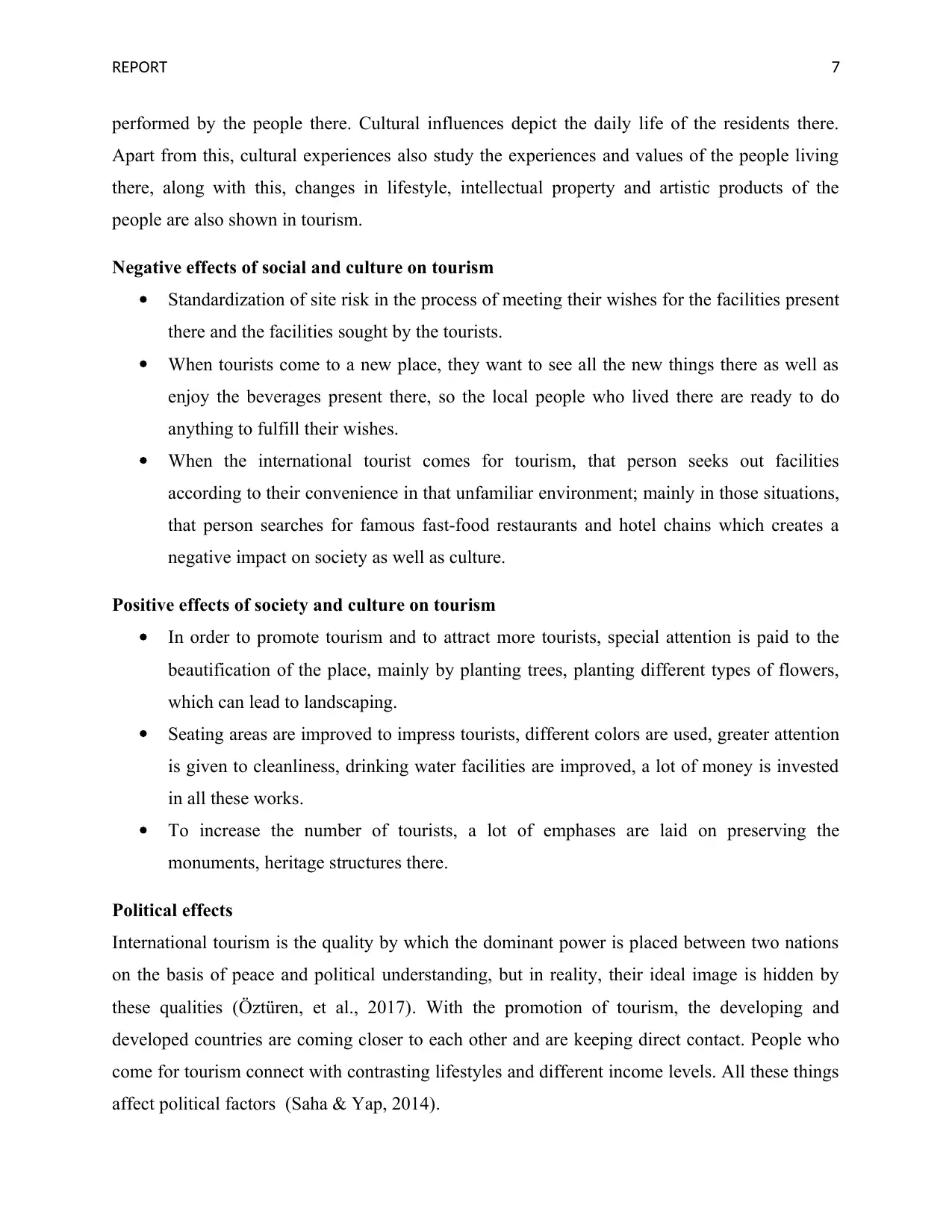
REPORT 7
performed by the people there. Cultural influences depict the daily life of the residents there.
Apart from this, cultural experiences also study the experiences and values of the people living
there, along with this, changes in lifestyle, intellectual property and artistic products of the
people are also shown in tourism.
Negative effects of social and culture on tourism
Standardization of site risk in the process of meeting their wishes for the facilities present
there and the facilities sought by the tourists.
When tourists come to a new place, they want to see all the new things there as well as
enjoy the beverages present there, so the local people who lived there are ready to do
anything to fulfill their wishes.
When the international tourist comes for tourism, that person seeks out facilities
according to their convenience in that unfamiliar environment; mainly in those situations,
that person searches for famous fast-food restaurants and hotel chains which creates a
negative impact on society as well as culture.
Positive effects of society and culture on tourism
In order to promote tourism and to attract more tourists, special attention is paid to the
beautification of the place, mainly by planting trees, planting different types of flowers,
which can lead to landscaping.
Seating areas are improved to impress tourists, different colors are used, greater attention
is given to cleanliness, drinking water facilities are improved, a lot of money is invested
in all these works.
To increase the number of tourists, a lot of emphases are laid on preserving the
monuments, heritage structures there.
Political effects
International tourism is the quality by which the dominant power is placed between two nations
on the basis of peace and political understanding, but in reality, their ideal image is hidden by
these qualities (Öztüren, et al., 2017). With the promotion of tourism, the developing and
developed countries are coming closer to each other and are keeping direct contact. People who
come for tourism connect with contrasting lifestyles and different income levels. All these things
affect political factors (Saha & Yap, 2014).
performed by the people there. Cultural influences depict the daily life of the residents there.
Apart from this, cultural experiences also study the experiences and values of the people living
there, along with this, changes in lifestyle, intellectual property and artistic products of the
people are also shown in tourism.
Negative effects of social and culture on tourism
Standardization of site risk in the process of meeting their wishes for the facilities present
there and the facilities sought by the tourists.
When tourists come to a new place, they want to see all the new things there as well as
enjoy the beverages present there, so the local people who lived there are ready to do
anything to fulfill their wishes.
When the international tourist comes for tourism, that person seeks out facilities
according to their convenience in that unfamiliar environment; mainly in those situations,
that person searches for famous fast-food restaurants and hotel chains which creates a
negative impact on society as well as culture.
Positive effects of society and culture on tourism
In order to promote tourism and to attract more tourists, special attention is paid to the
beautification of the place, mainly by planting trees, planting different types of flowers,
which can lead to landscaping.
Seating areas are improved to impress tourists, different colors are used, greater attention
is given to cleanliness, drinking water facilities are improved, a lot of money is invested
in all these works.
To increase the number of tourists, a lot of emphases are laid on preserving the
monuments, heritage structures there.
Political effects
International tourism is the quality by which the dominant power is placed between two nations
on the basis of peace and political understanding, but in reality, their ideal image is hidden by
these qualities (Öztüren, et al., 2017). With the promotion of tourism, the developing and
developed countries are coming closer to each other and are keeping direct contact. People who
come for tourism connect with contrasting lifestyles and different income levels. All these things
affect political factors (Saha & Yap, 2014).
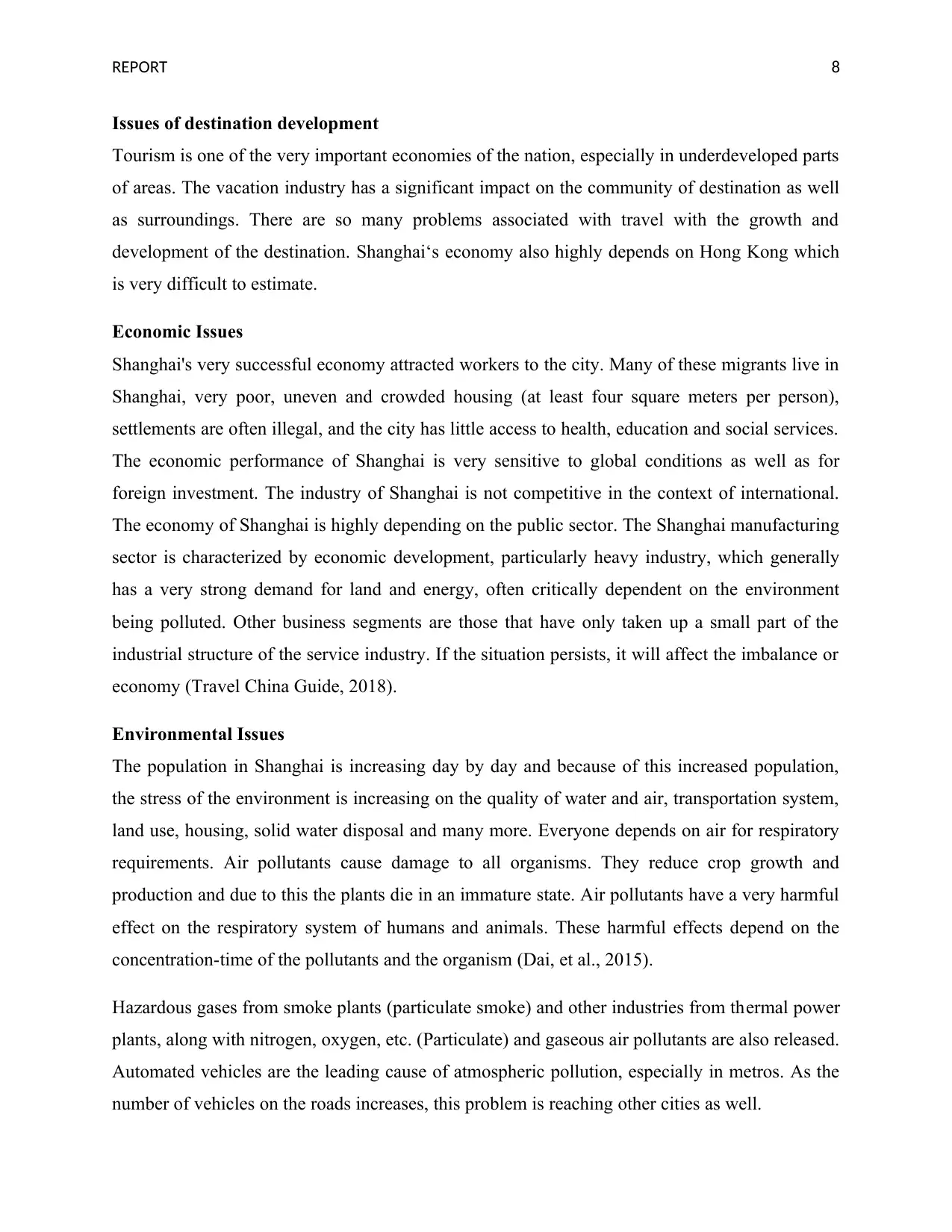
REPORT 8
Issues of destination development
Tourism is one of the very important economies of the nation, especially in underdeveloped parts
of areas. The vacation industry has a significant impact on the community of destination as well
as surroundings. There are so many problems associated with travel with the growth and
development of the destination. Shanghai‘s economy also highly depends on Hong Kong which
is very difficult to estimate.
Economic Issues
Shanghai's very successful economy attracted workers to the city. Many of these migrants live in
Shanghai, very poor, uneven and crowded housing (at least four square meters per person),
settlements are often illegal, and the city has little access to health, education and social services.
The economic performance of Shanghai is very sensitive to global conditions as well as for
foreign investment. The industry of Shanghai is not competitive in the context of international.
The economy of Shanghai is highly depending on the public sector. The Shanghai manufacturing
sector is characterized by economic development, particularly heavy industry, which generally
has a very strong demand for land and energy, often critically dependent on the environment
being polluted. Other business segments are those that have only taken up a small part of the
industrial structure of the service industry. If the situation persists, it will affect the imbalance or
economy (Travel China Guide, 2018).
Environmental Issues
The population in Shanghai is increasing day by day and because of this increased population,
the stress of the environment is increasing on the quality of water and air, transportation system,
land use, housing, solid water disposal and many more. Everyone depends on air for respiratory
requirements. Air pollutants cause damage to all organisms. They reduce crop growth and
production and due to this the plants die in an immature state. Air pollutants have a very harmful
effect on the respiratory system of humans and animals. These harmful effects depend on the
concentration-time of the pollutants and the organism (Dai, et al., 2015).
Hazardous gases from smoke plants (particulate smoke) and other industries from thermal power
plants, along with nitrogen, oxygen, etc. (Particulate) and gaseous air pollutants are also released.
Automated vehicles are the leading cause of atmospheric pollution, especially in metros. As the
number of vehicles on the roads increases, this problem is reaching other cities as well.
Issues of destination development
Tourism is one of the very important economies of the nation, especially in underdeveloped parts
of areas. The vacation industry has a significant impact on the community of destination as well
as surroundings. There are so many problems associated with travel with the growth and
development of the destination. Shanghai‘s economy also highly depends on Hong Kong which
is very difficult to estimate.
Economic Issues
Shanghai's very successful economy attracted workers to the city. Many of these migrants live in
Shanghai, very poor, uneven and crowded housing (at least four square meters per person),
settlements are often illegal, and the city has little access to health, education and social services.
The economic performance of Shanghai is very sensitive to global conditions as well as for
foreign investment. The industry of Shanghai is not competitive in the context of international.
The economy of Shanghai is highly depending on the public sector. The Shanghai manufacturing
sector is characterized by economic development, particularly heavy industry, which generally
has a very strong demand for land and energy, often critically dependent on the environment
being polluted. Other business segments are those that have only taken up a small part of the
industrial structure of the service industry. If the situation persists, it will affect the imbalance or
economy (Travel China Guide, 2018).
Environmental Issues
The population in Shanghai is increasing day by day and because of this increased population,
the stress of the environment is increasing on the quality of water and air, transportation system,
land use, housing, solid water disposal and many more. Everyone depends on air for respiratory
requirements. Air pollutants cause damage to all organisms. They reduce crop growth and
production and due to this the plants die in an immature state. Air pollutants have a very harmful
effect on the respiratory system of humans and animals. These harmful effects depend on the
concentration-time of the pollutants and the organism (Dai, et al., 2015).
Hazardous gases from smoke plants (particulate smoke) and other industries from thermal power
plants, along with nitrogen, oxygen, etc. (Particulate) and gaseous air pollutants are also released.
Automated vehicles are the leading cause of atmospheric pollution, especially in metros. As the
number of vehicles on the roads increases, this problem is reaching other cities as well.
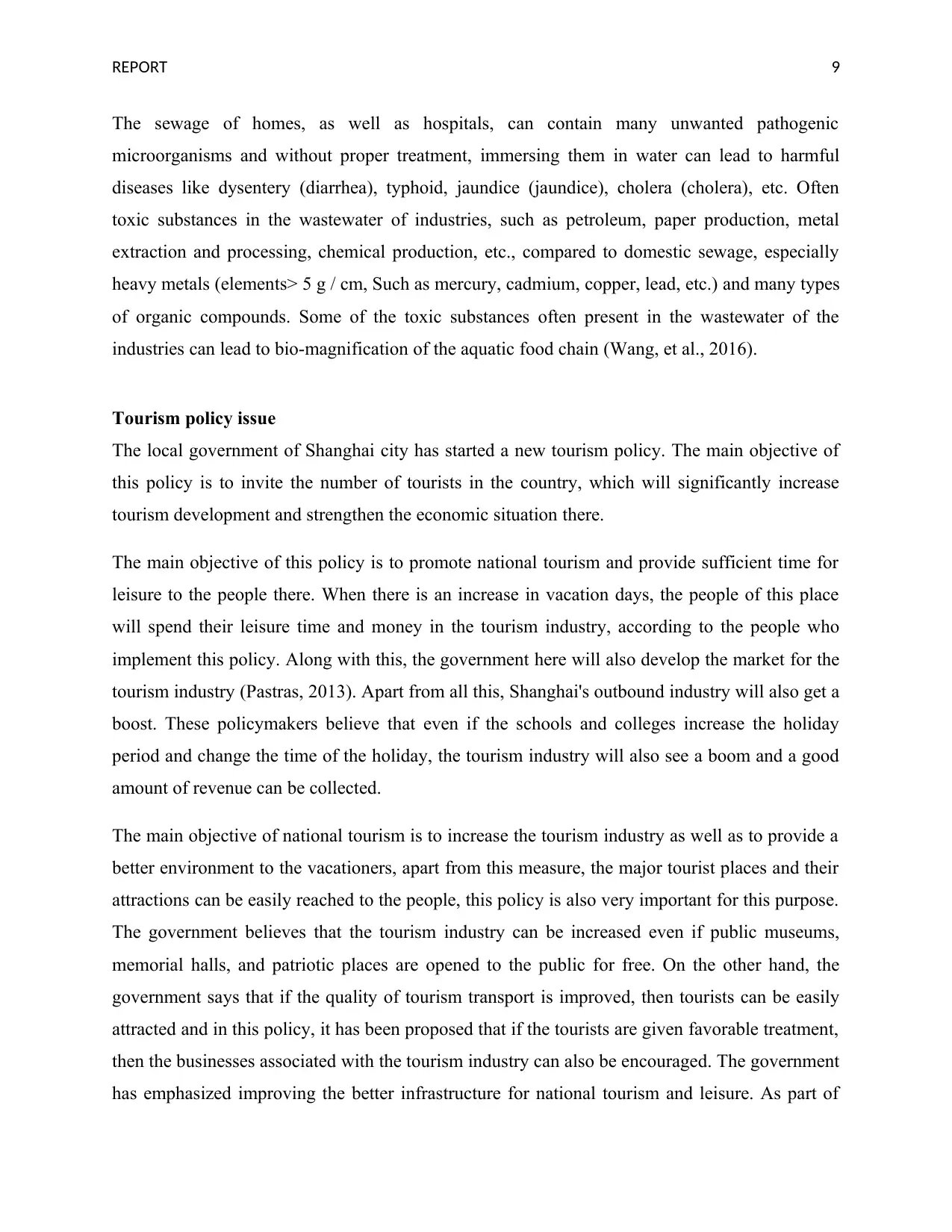
REPORT 9
The sewage of homes, as well as hospitals, can contain many unwanted pathogenic
microorganisms and without proper treatment, immersing them in water can lead to harmful
diseases like dysentery (diarrhea), typhoid, jaundice (jaundice), cholera (cholera), etc. Often
toxic substances in the wastewater of industries, such as petroleum, paper production, metal
extraction and processing, chemical production, etc., compared to domestic sewage, especially
heavy metals (elements> 5 g / cm, Such as mercury, cadmium, copper, lead, etc.) and many types
of organic compounds. Some of the toxic substances often present in the wastewater of the
industries can lead to bio-magnification of the aquatic food chain (Wang, et al., 2016).
Tourism policy issue
The local government of Shanghai city has started a new tourism policy. The main objective of
this policy is to invite the number of tourists in the country, which will significantly increase
tourism development and strengthen the economic situation there.
The main objective of this policy is to promote national tourism and provide sufficient time for
leisure to the people there. When there is an increase in vacation days, the people of this place
will spend their leisure time and money in the tourism industry, according to the people who
implement this policy. Along with this, the government here will also develop the market for the
tourism industry (Pastras, 2013). Apart from all this, Shanghai's outbound industry will also get a
boost. These policymakers believe that even if the schools and colleges increase the holiday
period and change the time of the holiday, the tourism industry will also see a boom and a good
amount of revenue can be collected.
The main objective of national tourism is to increase the tourism industry as well as to provide a
better environment to the vacationers, apart from this measure, the major tourist places and their
attractions can be easily reached to the people, this policy is also very important for this purpose.
The government believes that the tourism industry can be increased even if public museums,
memorial halls, and patriotic places are opened to the public for free. On the other hand, the
government says that if the quality of tourism transport is improved, then tourists can be easily
attracted and in this policy, it has been proposed that if the tourists are given favorable treatment,
then the businesses associated with the tourism industry can also be encouraged. The government
has emphasized improving the better infrastructure for national tourism and leisure. As part of
The sewage of homes, as well as hospitals, can contain many unwanted pathogenic
microorganisms and without proper treatment, immersing them in water can lead to harmful
diseases like dysentery (diarrhea), typhoid, jaundice (jaundice), cholera (cholera), etc. Often
toxic substances in the wastewater of industries, such as petroleum, paper production, metal
extraction and processing, chemical production, etc., compared to domestic sewage, especially
heavy metals (elements> 5 g / cm, Such as mercury, cadmium, copper, lead, etc.) and many types
of organic compounds. Some of the toxic substances often present in the wastewater of the
industries can lead to bio-magnification of the aquatic food chain (Wang, et al., 2016).
Tourism policy issue
The local government of Shanghai city has started a new tourism policy. The main objective of
this policy is to invite the number of tourists in the country, which will significantly increase
tourism development and strengthen the economic situation there.
The main objective of this policy is to promote national tourism and provide sufficient time for
leisure to the people there. When there is an increase in vacation days, the people of this place
will spend their leisure time and money in the tourism industry, according to the people who
implement this policy. Along with this, the government here will also develop the market for the
tourism industry (Pastras, 2013). Apart from all this, Shanghai's outbound industry will also get a
boost. These policymakers believe that even if the schools and colleges increase the holiday
period and change the time of the holiday, the tourism industry will also see a boom and a good
amount of revenue can be collected.
The main objective of national tourism is to increase the tourism industry as well as to provide a
better environment to the vacationers, apart from this measure, the major tourist places and their
attractions can be easily reached to the people, this policy is also very important for this purpose.
The government believes that the tourism industry can be increased even if public museums,
memorial halls, and patriotic places are opened to the public for free. On the other hand, the
government says that if the quality of tourism transport is improved, then tourists can be easily
attracted and in this policy, it has been proposed that if the tourists are given favorable treatment,
then the businesses associated with the tourism industry can also be encouraged. The government
has emphasized improving the better infrastructure for national tourism and leisure. As part of
Secure Best Marks with AI Grader
Need help grading? Try our AI Grader for instant feedback on your assignments.
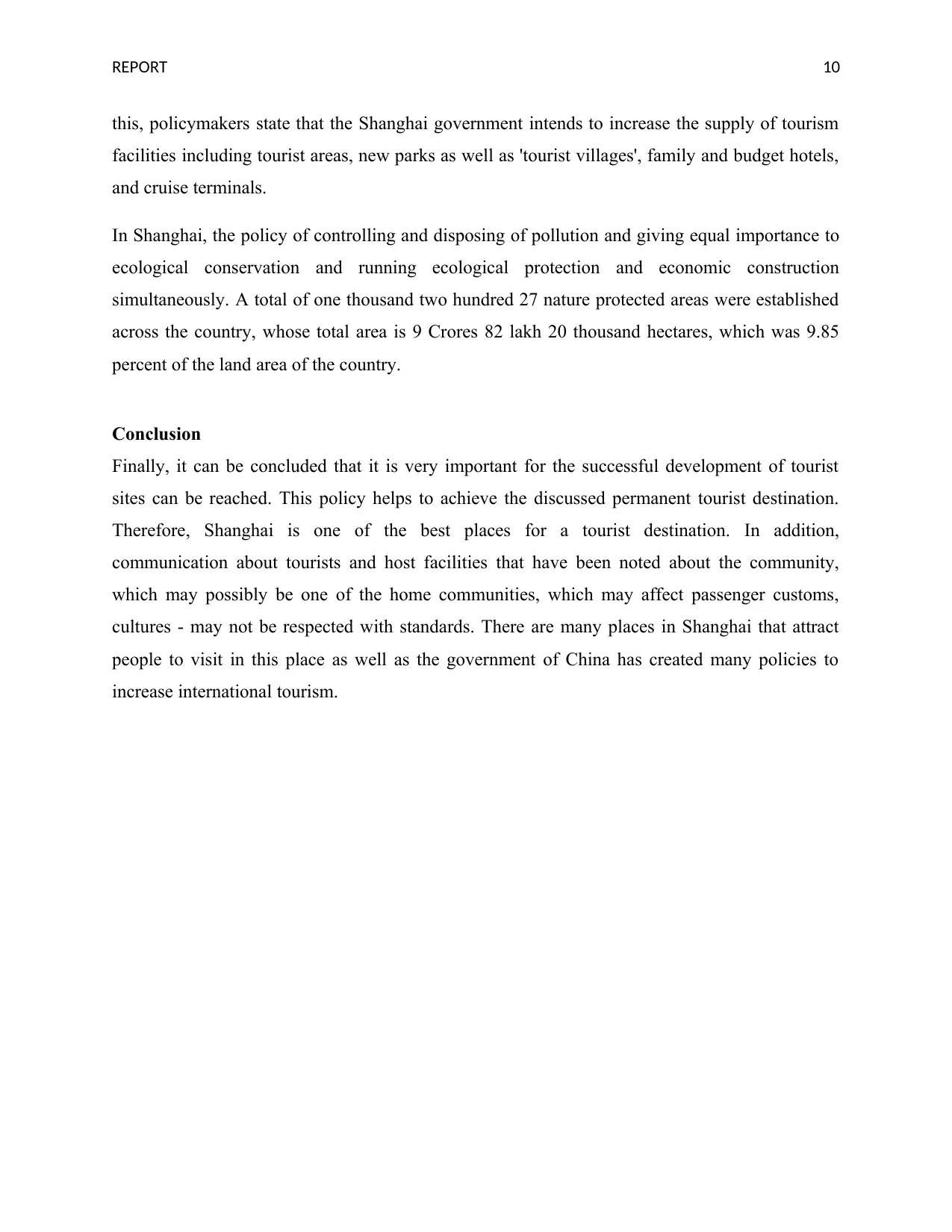
REPORT 10
this, policymakers state that the Shanghai government intends to increase the supply of tourism
facilities including tourist areas, new parks as well as 'tourist villages', family and budget hotels,
and cruise terminals.
In Shanghai, the policy of controlling and disposing of pollution and giving equal importance to
ecological conservation and running ecological protection and economic construction
simultaneously. A total of one thousand two hundred 27 nature protected areas were established
across the country, whose total area is 9 Crores 82 lakh 20 thousand hectares, which was 9.85
percent of the land area of the country.
Conclusion
Finally, it can be concluded that it is very important for the successful development of tourist
sites can be reached. This policy helps to achieve the discussed permanent tourist destination.
Therefore, Shanghai is one of the best places for a tourist destination. In addition,
communication about tourists and host facilities that have been noted about the community,
which may possibly be one of the home communities, which may affect passenger customs,
cultures - may not be respected with standards. There are many places in Shanghai that attract
people to visit in this place as well as the government of China has created many policies to
increase international tourism.
this, policymakers state that the Shanghai government intends to increase the supply of tourism
facilities including tourist areas, new parks as well as 'tourist villages', family and budget hotels,
and cruise terminals.
In Shanghai, the policy of controlling and disposing of pollution and giving equal importance to
ecological conservation and running ecological protection and economic construction
simultaneously. A total of one thousand two hundred 27 nature protected areas were established
across the country, whose total area is 9 Crores 82 lakh 20 thousand hectares, which was 9.85
percent of the land area of the country.
Conclusion
Finally, it can be concluded that it is very important for the successful development of tourist
sites can be reached. This policy helps to achieve the discussed permanent tourist destination.
Therefore, Shanghai is one of the best places for a tourist destination. In addition,
communication about tourists and host facilities that have been noted about the community,
which may possibly be one of the home communities, which may affect passenger customs,
cultures - may not be respected with standards. There are many places in Shanghai that attract
people to visit in this place as well as the government of China has created many policies to
increase international tourism.

REPORT 11
References List
CAB books, 2011. Tourist Destination Governance: Practice, Theory, and Issues. Oxfordshire:
CABI.
Dai, K. et al., 2015. Environmental issues associated with wind energy - A review. Renewable
Energy, Volume 75, p. 911(11).
Dimanche, F. & Reisinger, Y., 2010. International Tourism. Abingdon: Routledge.
Li, M. & Bihu, W., 2013. Urban Tourism in China. Abington-on- Thames: Routledge.
Lowry, L. L., 2016. The SAGE International Encyclopedia of Travel and Tourism. California:
SAGE Publications.
Ma, Y. et al., 2016. The General History Of Chinese Tourism Culture. Singapore: World
Scientific.
Öztüren, A., Sumaneeva, K., Gashenenkov, M. & Meredova, M., 2017. Potential Effects of
Disruptive Political Trends in International Tourism Market. International Journal of
Multicultural and Multireligious Understanding, 4(2), pp. 24-29.
Pastras, P., 2013. A STRATEGIC-RELATIONAL APPROACH TO TOURISM POLICY.
Annals of Tourism Research, Volume 43, p. 390(25).
Pine, R. J. & Qui , H. Z., 2013. Tourism and Hotel Development in China: From Political to
Economic Success. Abingdon-on-Thames: Routledge.
Saha, S. & Yap, G., 2014. The Moderation Effects of Political Instability and Terrorism on
Tourism Development: A Cross-Country Panel Analysis. Journal of Travel Research, 53(4), pp.
509-521.
Salat, S., 2017. Shanghai in the new economy of global flows shaping urban form and
connectedness in the digital age. Journal of Architecture and Urbanism, 41(2), pp. 145-161.
Shanghai Government, 2018. Statistical Yearbook 2018. [Online]
Available at: http://tjj.sh.gov.cn/tjnj/zgsh/nj2011.html
References List
CAB books, 2011. Tourist Destination Governance: Practice, Theory, and Issues. Oxfordshire:
CABI.
Dai, K. et al., 2015. Environmental issues associated with wind energy - A review. Renewable
Energy, Volume 75, p. 911(11).
Dimanche, F. & Reisinger, Y., 2010. International Tourism. Abingdon: Routledge.
Li, M. & Bihu, W., 2013. Urban Tourism in China. Abington-on- Thames: Routledge.
Lowry, L. L., 2016. The SAGE International Encyclopedia of Travel and Tourism. California:
SAGE Publications.
Ma, Y. et al., 2016. The General History Of Chinese Tourism Culture. Singapore: World
Scientific.
Öztüren, A., Sumaneeva, K., Gashenenkov, M. & Meredova, M., 2017. Potential Effects of
Disruptive Political Trends in International Tourism Market. International Journal of
Multicultural and Multireligious Understanding, 4(2), pp. 24-29.
Pastras, P., 2013. A STRATEGIC-RELATIONAL APPROACH TO TOURISM POLICY.
Annals of Tourism Research, Volume 43, p. 390(25).
Pine, R. J. & Qui , H. Z., 2013. Tourism and Hotel Development in China: From Political to
Economic Success. Abingdon-on-Thames: Routledge.
Saha, S. & Yap, G., 2014. The Moderation Effects of Political Instability and Terrorism on
Tourism Development: A Cross-Country Panel Analysis. Journal of Travel Research, 53(4), pp.
509-521.
Salat, S., 2017. Shanghai in the new economy of global flows shaping urban form and
connectedness in the digital age. Journal of Architecture and Urbanism, 41(2), pp. 145-161.
Shanghai Government, 2018. Statistical Yearbook 2018. [Online]
Available at: http://tjj.sh.gov.cn/tjnj/zgsh/nj2011.html
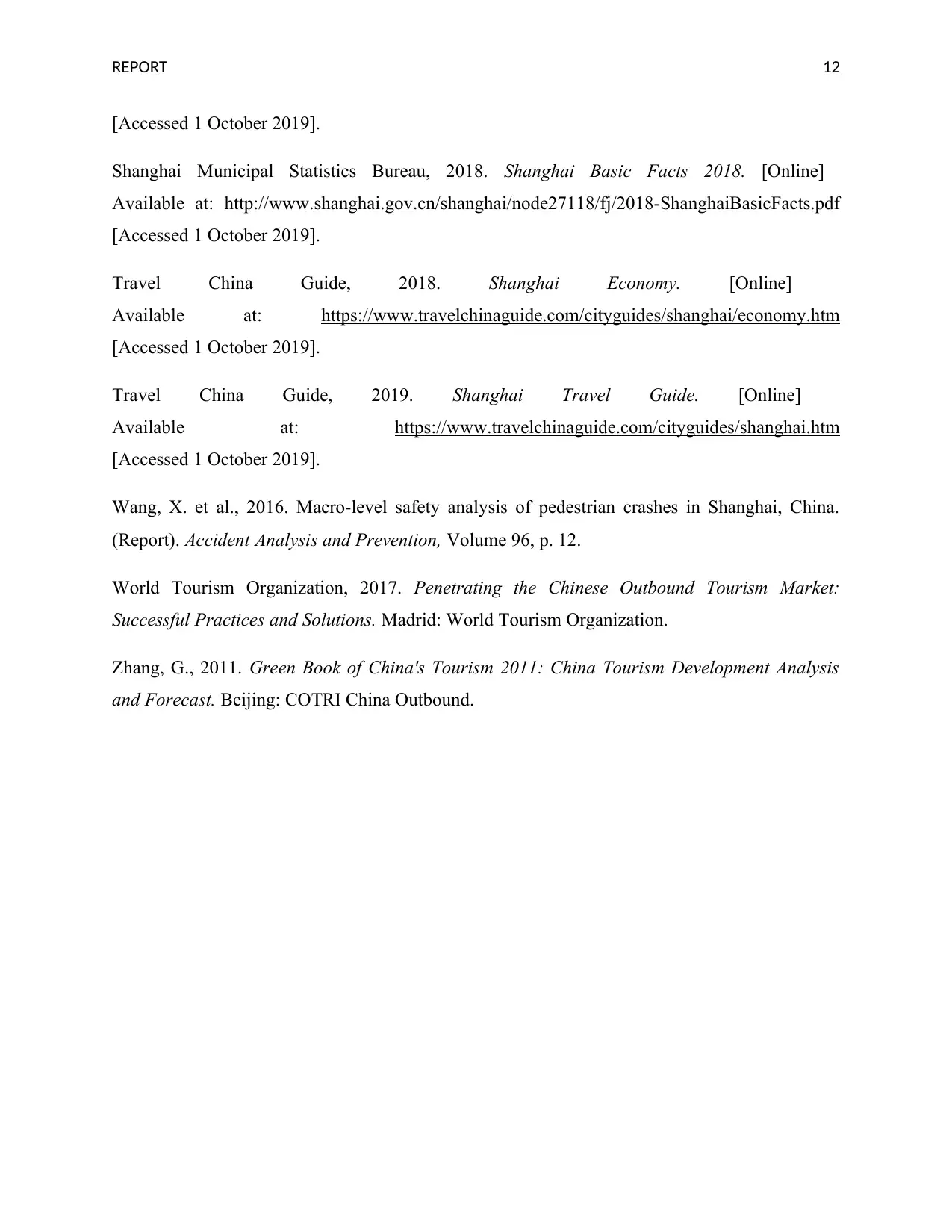
REPORT 12
[Accessed 1 October 2019].
Shanghai Municipal Statistics Bureau, 2018. Shanghai Basic Facts 2018. [Online]
Available at: http://www.shanghai.gov.cn/shanghai/node27118/fj/2018-ShanghaiBasicFacts.pdf
[Accessed 1 October 2019].
Travel China Guide, 2018. Shanghai Economy. [Online]
Available at: https://www.travelchinaguide.com/cityguides/shanghai/economy.htm
[Accessed 1 October 2019].
Travel China Guide, 2019. Shanghai Travel Guide. [Online]
Available at: https://www.travelchinaguide.com/cityguides/shanghai.htm
[Accessed 1 October 2019].
Wang, X. et al., 2016. Macro-level safety analysis of pedestrian crashes in Shanghai, China.
(Report). Accident Analysis and Prevention, Volume 96, p. 12.
World Tourism Organization, 2017. Penetrating the Chinese Outbound Tourism Market:
Successful Practices and Solutions. Madrid: World Tourism Organization.
Zhang, G., 2011. Green Book of China's Tourism 2011: China Tourism Development Analysis
and Forecast. Beijing: COTRI China Outbound.
[Accessed 1 October 2019].
Shanghai Municipal Statistics Bureau, 2018. Shanghai Basic Facts 2018. [Online]
Available at: http://www.shanghai.gov.cn/shanghai/node27118/fj/2018-ShanghaiBasicFacts.pdf
[Accessed 1 October 2019].
Travel China Guide, 2018. Shanghai Economy. [Online]
Available at: https://www.travelchinaguide.com/cityguides/shanghai/economy.htm
[Accessed 1 October 2019].
Travel China Guide, 2019. Shanghai Travel Guide. [Online]
Available at: https://www.travelchinaguide.com/cityguides/shanghai.htm
[Accessed 1 October 2019].
Wang, X. et al., 2016. Macro-level safety analysis of pedestrian crashes in Shanghai, China.
(Report). Accident Analysis and Prevention, Volume 96, p. 12.
World Tourism Organization, 2017. Penetrating the Chinese Outbound Tourism Market:
Successful Practices and Solutions. Madrid: World Tourism Organization.
Zhang, G., 2011. Green Book of China's Tourism 2011: China Tourism Development Analysis
and Forecast. Beijing: COTRI China Outbound.
1 out of 13
Related Documents
Your All-in-One AI-Powered Toolkit for Academic Success.
+13062052269
info@desklib.com
Available 24*7 on WhatsApp / Email
![[object Object]](/_next/static/media/star-bottom.7253800d.svg)
Unlock your academic potential
© 2024 | Zucol Services PVT LTD | All rights reserved.





